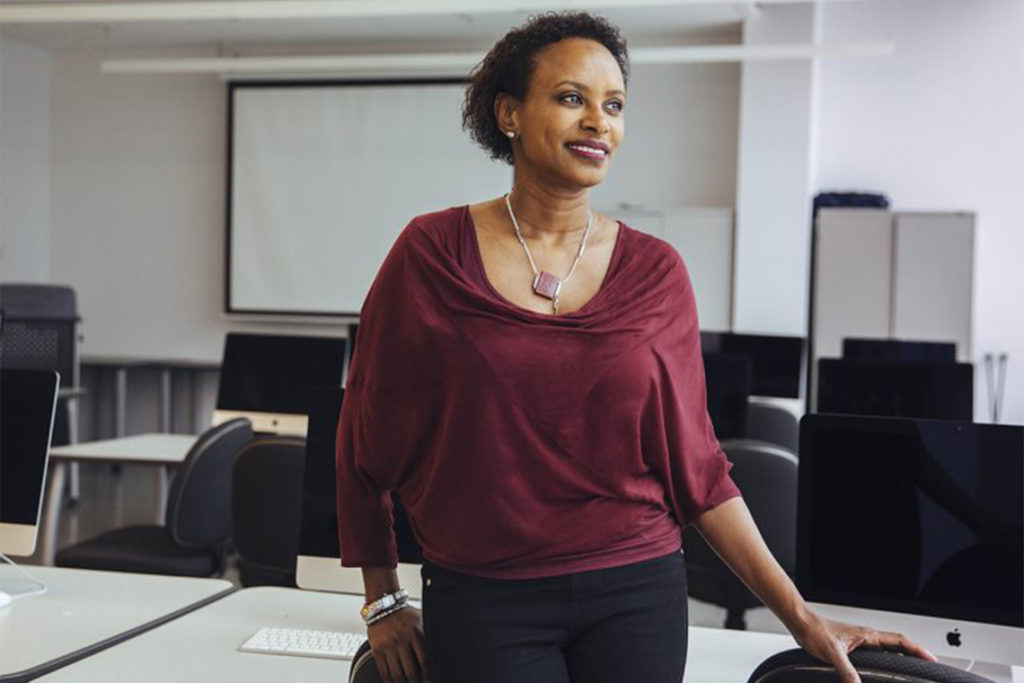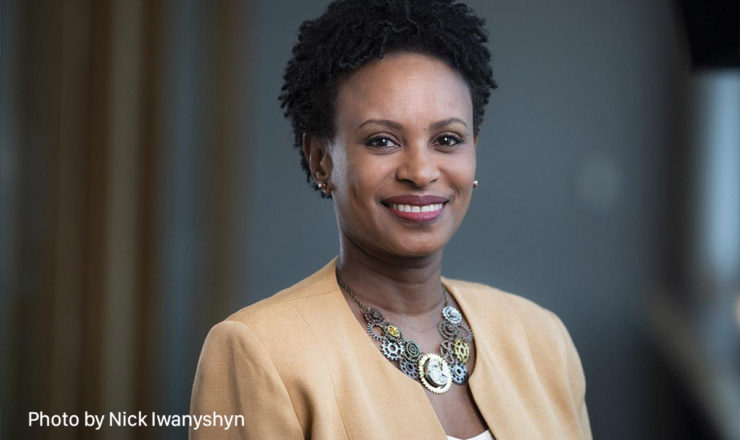When Professor Rhonda McEwen learned that her daughter was on the autism spectrum, she began to think about communications technology in new ways
A casual conversation led to Professor Rhonda McEwen’s home life and work life colliding just over 10 years ago. That’s when her daughter’s kindergarten teacher – who worked exclusively with special needs children – mentioned how much the students loved using an iPod touch. When McEwen went home that night, it hit her: “I’m studying social communication. I’m studying these devices. Why wouldn’t I study this population?”
McEwen, who is now the Vice-Principal, Academic and Dean of U of T Mississauga, was finishing her PhD on whether cellphones helped first-year university students build new friendships. While she had long been interested in how mobile technology was transforming communication among many groups – students, the elderly – she hadn’t yet thought to study how emerging technologies could enable communication for those without the ability to speak.
When McEwen first learned her daughter was on the autism spectrum and would likely be nonverbal for life, it pushed her to think differently about communication – especially challenging the enduring bias that those who don’t speak must be of a lesser intellect. While McEwen was already critical of that assumption, observing her daughter prompted a desire to find new ways for her daughter to reach out.
“As a mother, I looked in those eyes and I saw intelligence, I saw desire, I saw motivation,” says McEwen. “I also saw difficulty in trying to break through.”
While it was clear the iPod touch warranted further study, there were obvious challenges: the ethics approval required to work with children with special needs, and the logistical challenge of collecting data from kids who weren’t likely to respond well to researchers in the classroom. But that only got McEwen more excited about the work.
“I love a problem,” says McEwen, who has a graduate appointment with the Faculty of Information. She trained teachers to collect data and then, after following the progress of students in grades 7 through 12 over five months, completed a study of touch-screen use by special needs students. McEwen and her collaborators found that although there were limitations in the software, using the device had positive effects on attention and motivation – it boosted confidence and also encouraged children to help each other learn.
Although it was a small study – following 25 students – the implications were massive. “This was the first time these kids were starting to demonstrate a bit of what was inside that seemed locked away,” says McEwen. “For decades, autism was seen as socially exclusive. I would read that these kids want to be in their own world. That language has fallen away since we started giving them ways to communicate with and through the device.”
McEwen is infinitely curious about the role technology can play in our lives. But there’s a driving principle that distinguishes her from tech evangelists and critics alike: she’s interested in exploring both the possibilities and the limits of how technology can be used for communication.
For instance, McEwen emphasizes that there’s no one-size-fits-all solution – more tech in the classroom isn’t always better. In researching Understanding Tablets from Early Childhood to Adulthood, a book she co-wrote with Adam Dubé, an assistant professor at McGill University, they found technology could be incredibly distracting for students with attention deficit disorder.
While McEwen started her academic career interested in the social consequences of device use, in the last decade she has become interested in the cognitive consequences. How do devices contribute to or hamper the way that we understand the world? How do they support or limit expression and social connectivity? How can they help or harm people who struggle to communicate?
To answer these questions, McEwen reaches across disciplines. Her research spans science, technology, psychology and even human physiology. She’s currently working with Michelle Lui, a post-doctoral fellow examining learning in virtual reality. (Lui has collaborated with McEwen on such research as the use of eye-gaze technology for students with complex needs.) This drive to pursue truly original ideas is part of what Lui thinks helps McEwen stand out as a researcher. “The way Rhonda thinks about the work is very cutting edge,” says Lui. “She’s not afraid to go into an area if there’s not an established way of doing things.”

McEwen began her academic career at the University of the West Indies in her homeland of Trinidad, and also worked at the Telecommunications Service of Trinidad and Tobago. After earning an MBA and MSc abroad, McEwen went into consulting before moving to Toronto with her partner in 2003. But she was getting restless as a consultant – she wasn’t able to dig deep into the problems she found interesting.
McEwen’s drive to follow her own curiosity led her to pursue a PhD at the University of Toronto, studying how cellphones helped first-year U of T and Ryerson students build new friendships and maintain old ones during a major life transition. What McEwen found surprised her: the use of cellphones made it less likely commuter students would develop support networks at university. They were more likely to rely on their established relationships: when they felt lonely, it was easier to pull out a phone and text an old friend rather than to turn to a stranger in English Literature 101 and try to make a new one.
This showed her two sides of device use: while cellphones could be used to build intimacy, they could also be used to avoid it. “You create this kind of barrier around yourself, using the device as a gatekeeper of your social life and also as a presentation of self to your networks,” says McEwen.
McEwen’s work with children with complex needs has shown a different impact of technology: instead of acting as a barrier, it can be a bridge. Her latest published research focuses on how children aged four to 12 with “profound physical disabilities” – including Rett Syndrome, cerebral palsy and seizure disorder – use “eye-gaze” technology for tasks such as vocabulary-building. The software picks up where a user is looking, so a child can look at a desired icon on a screen to communicate – for instance, looking at an image of a dog will prompt the device to say “dog.”
McEwen and her collaborators not only found that eye-gaze technology was a way for most of the students to communicate with their teachers, but also that there was an interaction happening with the device. They see the device not just as a tool but as a partner in communication. This means that as students became more comfortable with the device, they relied less on teachers. McEwen uses the example of bringing out an iPad for her daughter when the family goes out to dinner. McEwen won’t have it out the whole time, but even knowing it’s there provides her daughter with comfort and a way for her to “be in the world.”
Relatedly, the time students spent with the device wasn’t significantly affected by whether or not the teacher who was directing the exercise was familiar to them. This could mean more independence for a child with complex needs, and less reliance on familiar faces. (Researchers, including McEwen, have typically assumed that the children will perform best when activities are directed by trusted adults.) This, in turn, could ease the workload of parents and teachers who are often intensely involved with these students.
McEwen has also looked into how these kinds of technologies can be incorporated into a school’s curriculum, how they can be used to assess students and how a child’s progress can be tracked. She credits her daughter, who is now 16, for revealing these research possibilities: “She really was the one who drew my attention to a community that is more deserving in many ways of what these technologies potentially can offer.”
Written by Sadiya Ansari
Originally posted on University of Toronto Magazine

